Key takeaways:
- Define your game’s vision clearly to guide design and gameplay decisions effectively.
- Create a comprehensive game design document (GDD) to prevent scope creep and maintain focus.
- Build an early prototype to gather feedback and iterate on game mechanics quickly.
- Establish realistic timelines and budgets while assembling a passionate, diverse team for project success.
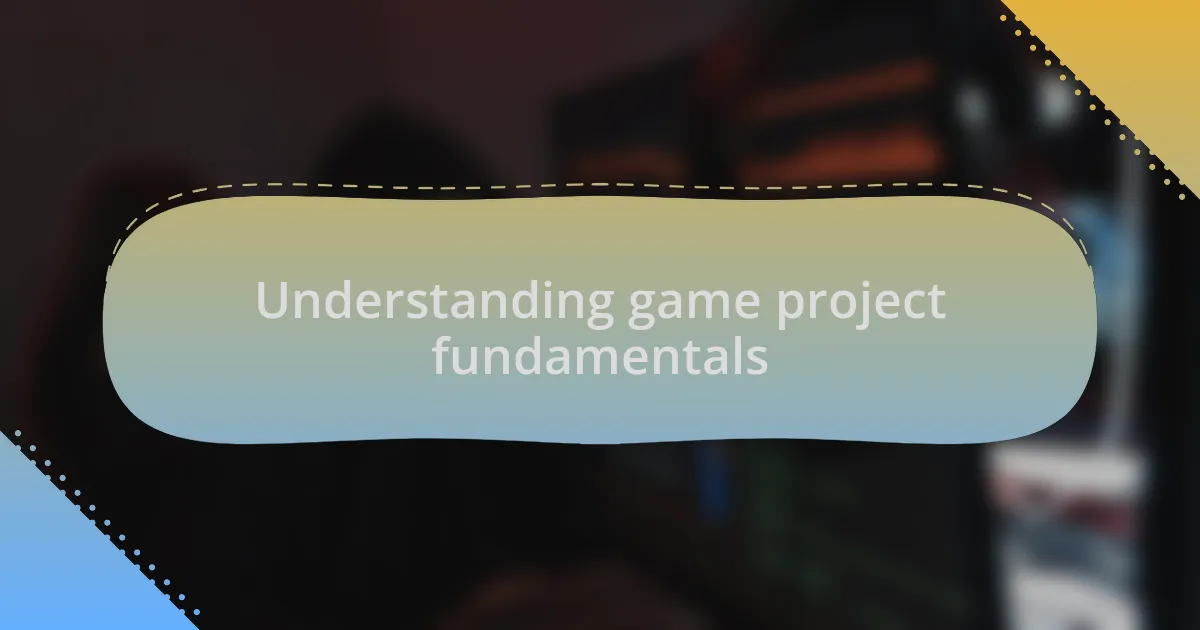
Understanding game project fundamentals
When diving into a game project, I’ve found that grasping its core fundamentals is essential to set the stage for success. For me, it often begins with defining the game’s vision; what experience do I want players to have? This clarity fuels every decision, from design choices to gameplay mechanics.
One key aspect I always pay attention to is the importance of a solid game design document (GDD). It feels like a compass for the entire project; without it, I’ve struggled to keep my ideas aligned and avoid scope creep. Have you ever started with one concept only to be sidetracked by new ideas? I certainly have, and a GDD helps me stay the course, giving me a clear reference point to return to when distractions arise.
I also emphasize building a prototype early on. The hands-on experience of creating a rough version is invaluable. It’s where I often uncover what truly resonates with players and what falls flat. I remember the excitement I felt during my first prototype phase, realizing how much I learned from quickly iterating on feedback. Isn’t it fascinating how sometimes, the simplest ideas become the most engaging?
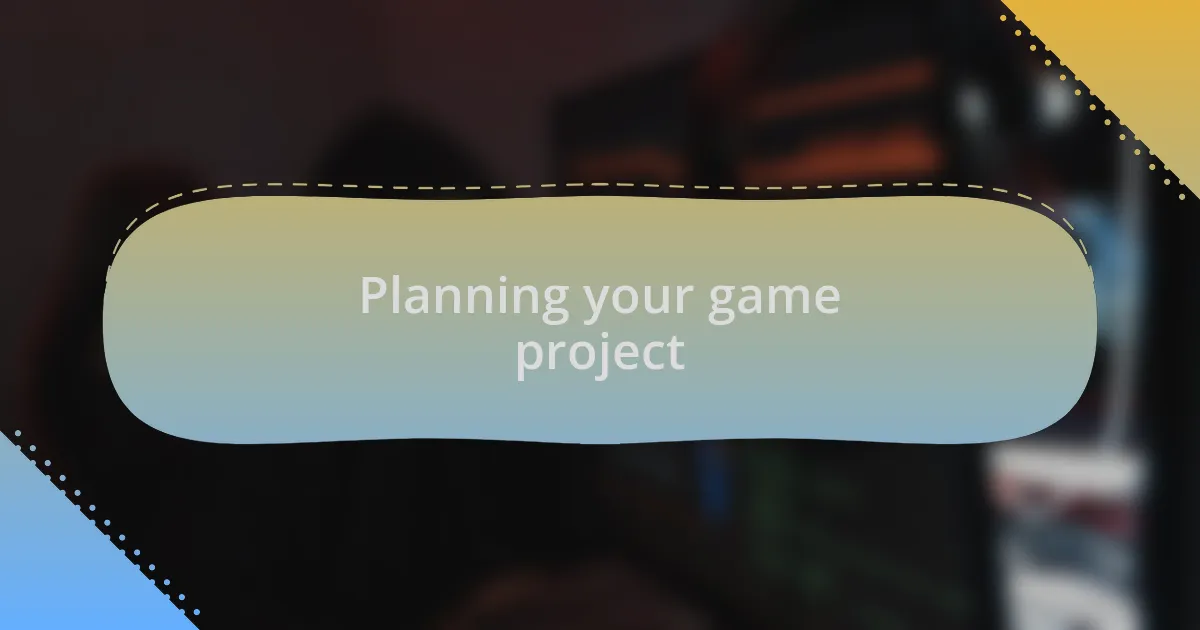
Planning your game project
When it comes to planning a game project, I believe that setting realistic timelines is crucial. In my experience, I’ve often underestimated how long certain tasks can take, which led to frustration down the line. Have you ever been caught in a time crunch that made the creative process feel rushed? I’ve certainly felt that pressure. Breaking the project into manageable phases allows me to focus on quality without the looming anxiety of a deadline hanging over my head.
Creating a budget is another critical component that I can’t overlook. I recall a project where I didn’t track expenses very closely, and I was shocked to find my resources dwindling faster than I anticipated. Establishing a budget helps ensure I allocate funds wisely for elements like software, graphics, or even hiring talent. How do you balance creativity and cost? For me, it’s about prioritizing the essentials that contribute to the game’s vision, while being flexible enough to adjust as the project evolves.
Finally, I can’t stress enough the importance of assembling a passionate team. I’ve seen how collaboration can elevate a project beyond what I initially envisioned. Have you ever been in a team where everyone brought their own unique strengths to the table? It’s invigorating! I’ve learned that diverse skills and perspectives can spark innovation and enhance problem-solving. Bringing the right people together sets a strong foundation for a successful game project.
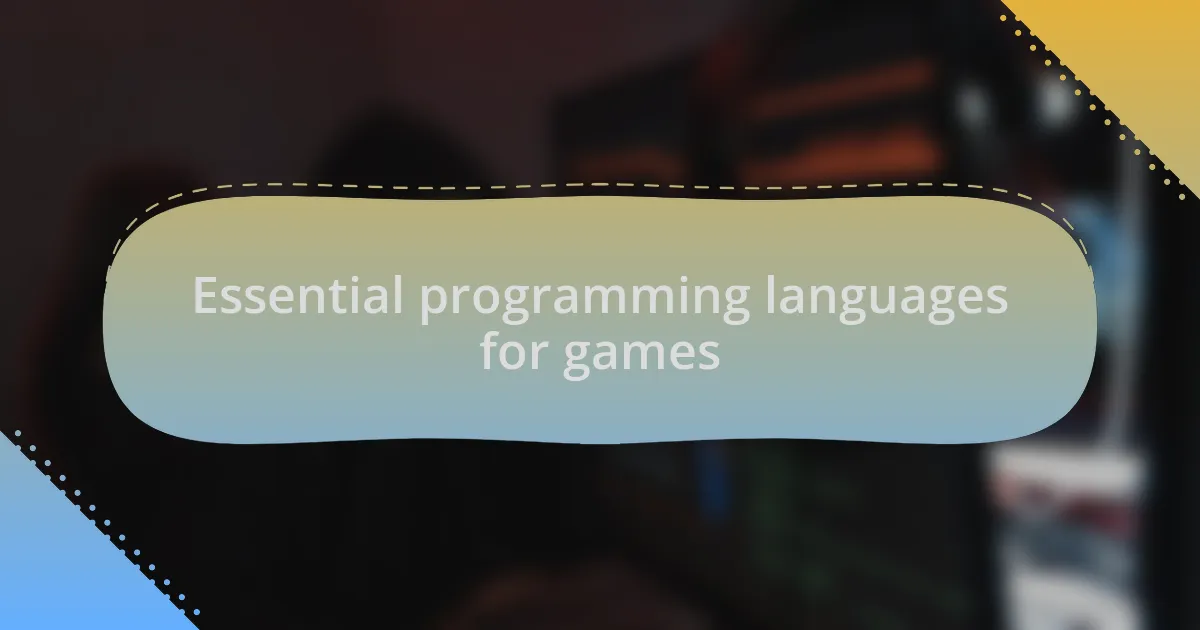
Essential programming languages for games
When it comes to programming languages essential for games, one that stands out is C++. I remember my first encounter with C++ while developing a simple platformer. The language’s power and flexibility allowed me to optimize performance, especially with graphics. Have you ever marveled at how a game runs smoothly? C++ is often the backbone behind that fluidity, thanks to its ability to manipulate system resources effectively.
Another significant language in game development is C#. When I transitioned into using Unity, C# became my go-to. Its user-friendly syntax and the rich ecosystem of tools and libraries made the process exhilarating. I often found myself experimenting with different mechanics, and I appreciated how quickly I could test ideas. Isn’t it motivating when a language empowers your creativity?
Lastly, I can’t overlook Python, especially for rapid prototyping and scripting. While it may not be the main language for high-performance games, I’ve utilized Python for developing game tools and automation scripts. It’s a gentle reminder that, even in the serious world of game programming, a language that’s easy to read can still play a pivotal role. Have you considered how using a versatile language like Python could streamline your workflow? It’s all about finding the right fit for your project’s needs.
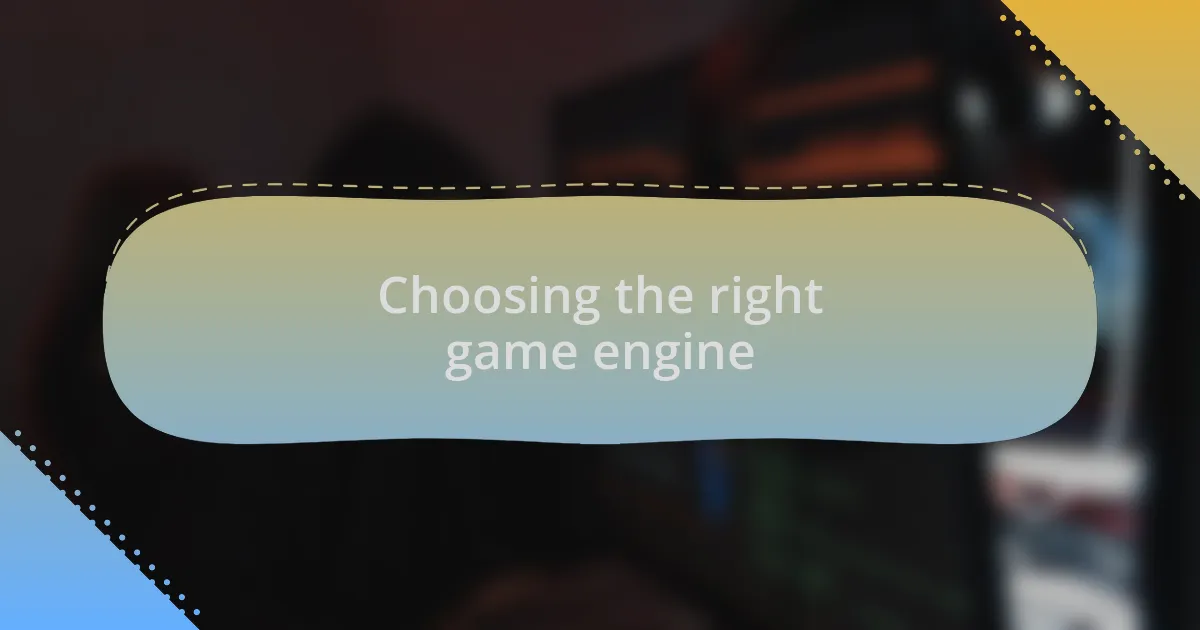
Choosing the right game engine
When I set out to choose a game engine, the options can feel overwhelming. Each engine has its unique strengths and weaknesses, and I recall spending hours comparing Unity and Unreal Engine. Unity’s user-friendly interface appealed to my desire to iterate quickly, while Unreal’s stunning graphics capabilities captivated my imagination. Have you ever found yourself torn between two great choices? Sometimes, it helps to list your project requirements and see which engine meets them best.
One thing I always consider is the community support surrounding an engine. I remember struggling with a challenging bug during a project when I reached out to the Unreal community. The response was almost instantaneous, and I felt a wave of relief knowing I wasn’t alone. Communities can be invaluable, especially when you’re navigating the complexities of game development. Isn’t it reassuring to know you have support when you hit a roadblock?
Lastly, I believe one of the most crucial factors is the platform for which you’re developing. For instance, when I wanted to explore mobile game development, I leaned heavily towards Unity due to its robust support for mobile platforms. This decision made a significant difference in optimizing my game for touch controls. Have you thought about how the platform might shape your engine choice? It’s essential to match your vision with the right engine to enhance your project’s success.
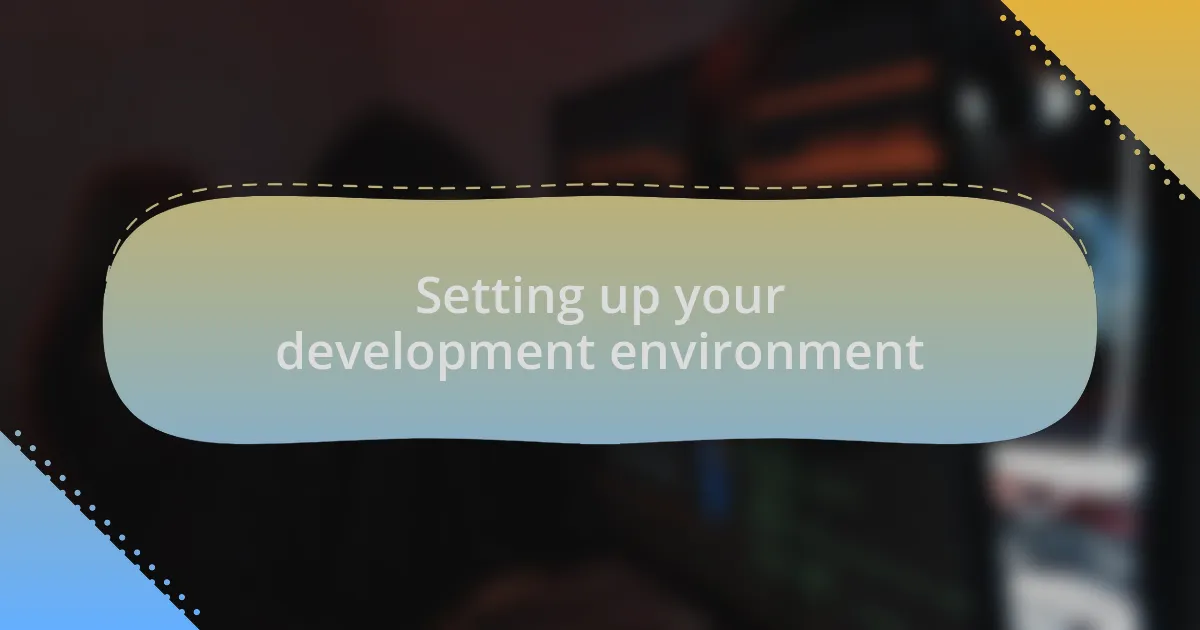
Setting up your development environment
Setting up a development environment is critical to your game project’s success. I remember the first time I attempted to configure my environment for a new game; it felt like solving a complex puzzle. I quickly learned that having the right tools, like an IDE or code editor, made all the difference in my productivity. Have you found that certain tools resonate with you and your workflow?
It’s also essential to ensure all necessary libraries and frameworks are installed. I once spent an entire day troubleshooting an issue, only to discover I hadn’t installed a required dependency. That experience taught me the importance of double-checking everything before diving into code. Have you experienced similar frustrations? It’s a valuable lesson in the importance of preparation.
Lastly, don’t overlook version control systems, such as Git. Embracing version control early in my projects saved me from countless headaches down the road. I remember feeling a sense of relief when I could easily revert changes after a feature didn’t pan out. Have you considered how version control could streamline your development process? It’s a powerful ally, ensuring that you can experiment freely while keeping your project organized.
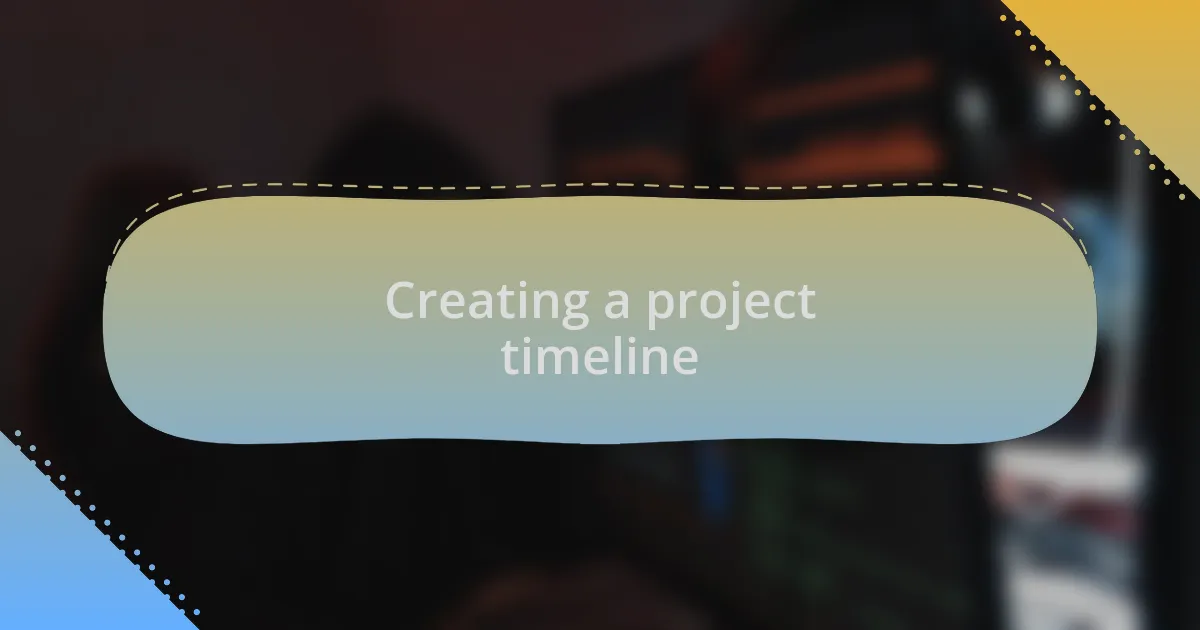
Creating a project timeline
Creating a project timeline is essential for keeping your game development on track. I vividly remember when I first tried to map out my timeline; the excitement quickly turned to overwhelm as I juggled deadlines and tasks. Breaking everything down into manageable milestones helped me regain my focus. Have you found that transforming a daunting project into smaller tasks makes it more approachable?
When I established a timeline for a recent game, I included buffers for unexpected challenges. This foresight proved invaluable when I encountered technical hurdles that delayed progress. It’s easy to underestimate how long something will take, isn’t it? I learned that allowing for flexibility can relieve a lot of stress in the long run.
Finally, I always aim to revisit and adjust my timeline regularly. Reflecting on progress not only keeps me accountable but also allows me to celebrate small wins along the way. Have you tried scheduling regular check-ins with yourself or your team? Those moments can be motivation boosters, reinforcing that you’re moving in the right direction, even if the finish line seems far away.
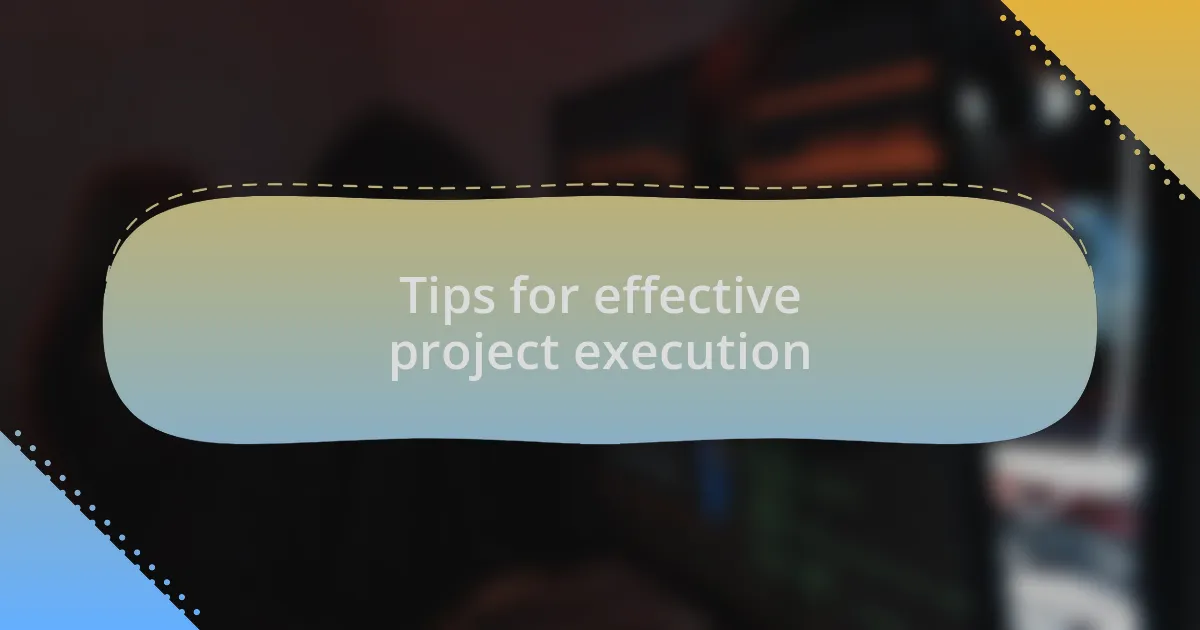
Tips for effective project execution
One of the most effective tips for project execution is maintaining open communication within your team. I recall a project where miscommunication led to duplicated efforts and wasted time. It taught me that having regular check-ins, even if they’re brief, can keep everyone aligned on goals and expectations. Sometimes, I wonder how different things could have been if we had emphasized transparency early on. Have you experienced similar outcomes when clarity is prioritized?
Prioritizing tasks based on their impact and urgency can significantly enhance productivity. In my early game projects, I often tackled the easiest tasks first, which left critical components sidelined and delayed the whole process. I learned that focusing on high-priority features not only propels the project forward but also boosts morale as tangible progress is made. Do you find that identifying what’s essential helps you stay motivated?
Adapting and learning from setbacks is crucial for successful project execution. Once, I faced a major setback when a key piece of technology failed during development. Instead of viewing it as a disaster, I approached it as a learning opportunity. This shift in perspective made the process less daunting, and it turned out to be a pivotal moment that improved my problem-solving skills. Have you been able to embrace challenges in a similar way?